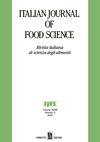10-Hydroxydec-2-enoic acid enhances the erythrocyte membrane fluidity via interacting with phosphatidylcholine and phosphatidylethanolamine
IF 3.3
4区 农林科学
Q2 FOOD SCIENCE & TECHNOLOGY
引用次数: 0
Abstract
10-Hydroxydec-2-enoic acid (10-HDA), the unique substance in the natural food royal jelly, is an unsaturated hydroxyl fatty acid with the bio-activity to guard against cell or tissue damages. However, the relevant mechanisms still remain largely unknown. Here, using a mouse erythrocyte model, whether the fluidity of plasma membrane is influenced by 10-HDA was investigated. 10-HDA was shown to enhance the erythrocyte membrane fluidity and to rescue the fluidity from •OH toxicity. In such occasions, 10-HDA promoted the dissolved O2 level in erythrocyte suspension thereof. The levels of β-actin and band 4.1 protein were not affected by 10-HDA in erythrocytes. In the framework of density functional theory, 10-HDA may interact with phosphatidylcholine and phosphatidy-lethanolamine, the major components of membrane lipid bilayer. This was evidenced by the fact that 10-HDA was detectable in erythrocytes after its addition to the erythrocyte suspension. Moreover, the fluorescent intensity of erythrocytes stained by the membrane probe DiIC18(5) increased with 10-HDA treatment. Hence, 10-HDA could regulate the erythrocyte membrane fluidity and the release of O2 from erythrocytes via targeting lipids rather than proteins. Our data cast light on the elucidation of the mechanism of 10-HDA modulating cell functionality and the utilization of 10-HDA in remedying the erythrocyte membrane fluidity-associated symptoms.10-羟基癸-2-烯酸通过与磷脂酰胆碱和磷脂酰乙醇胺相互作用增强红细胞膜流动性
10-羟基-2-烯酸(10-HDA)是天然食品蜂王浆中特有的一种不饱和羟基脂肪酸,具有防止细胞或组织损伤的生物活性。然而,相关的机制在很大程度上仍然是未知的。本文采用小鼠红细胞模型,研究了10-HDA对质膜流动性的影响。10-HDA可以增强红细胞膜的流动性,使其免受•OH毒性的影响。在这种情况下,10-HDA促进其红细胞悬液中溶解O2水平。红细胞β-肌动蛋白和4.1带蛋白水平未受10-HDA的影响。在密度泛函理论的框架下,10-HDA可能与磷脂酰胆碱和磷脂-乙醇胺相互作用,磷脂-乙醇胺是膜脂双分子层的主要成分。10-HDA加入红细胞悬浮液后,在红细胞中可检测到这一事实证明了这一点。此外,膜探针DiIC18(5)染色的红细胞荧光强度随着10-HDA的处理而增加。因此,10-HDA可能通过靶向脂质而非蛋白质来调节红细胞膜流动性和红细胞的氧释放。我们的数据阐明了10-HDA调节细胞功能的机制,并利用10-HDA治疗红细胞膜流动性相关症状。
本文章由计算机程序翻译,如有差异,请以英文原文为准。
求助全文
约1分钟内获得全文
求助全文
来源期刊

Italian Journal of Food Science
工程技术-食品科技
CiteScore
4.20
自引率
0.00%
发文量
33
审稿时长
>36 weeks
期刊介绍:
"Italian Journal of Food Science" is an international journal publishing original, basic and applied papers, reviews, short communications, surveys and opinions on food science and technology with specific reference to the Mediterranean Region. Its expanded scope includes food production, food engineering, food management, food quality, shelf-life, consumer acceptance of foodstuffs, food safety and nutrition, energy and environmental aspects of food processing on the whole life cycle.
Reviews and surveys on specific topics relevant to the advance of the Mediterranean food industry are particularly welcome.
 求助内容:
求助内容: 应助结果提醒方式:
应助结果提醒方式:


